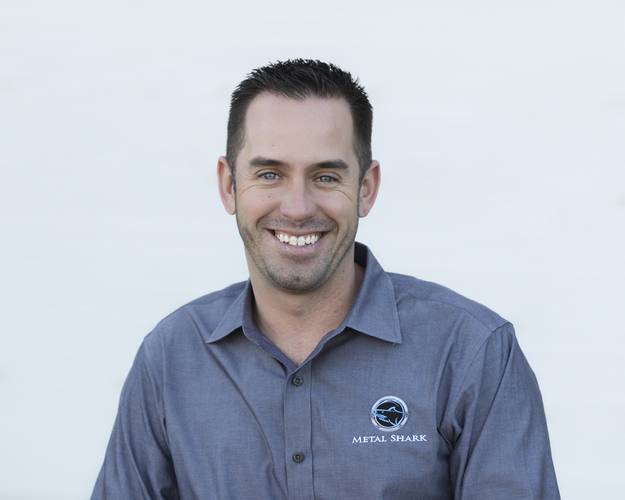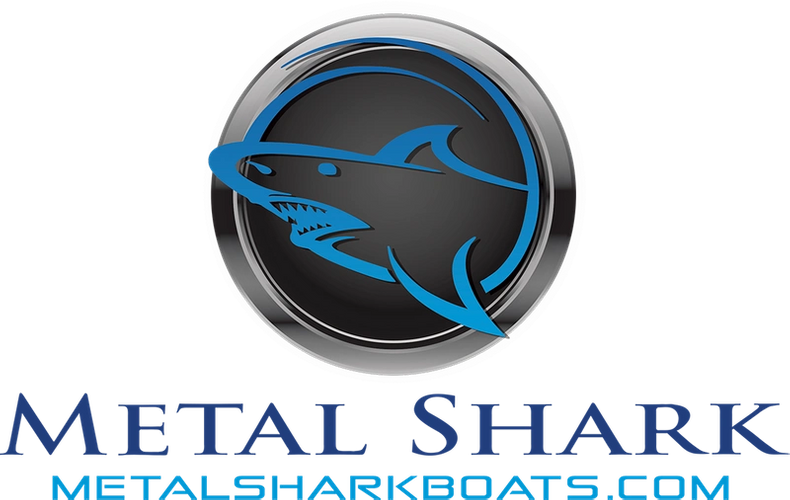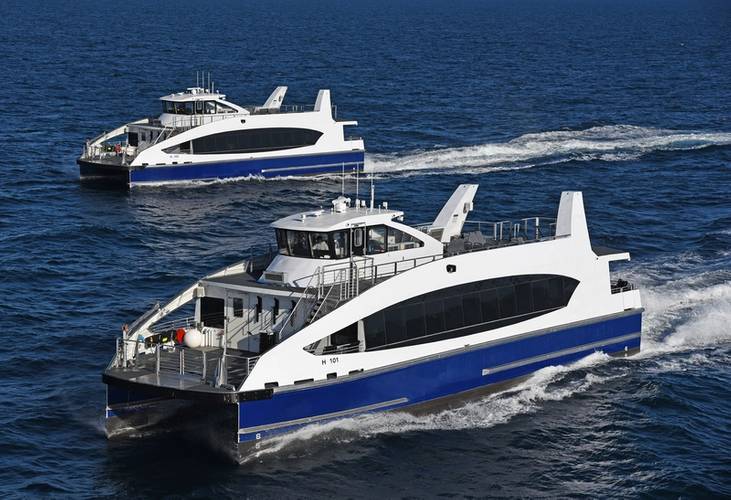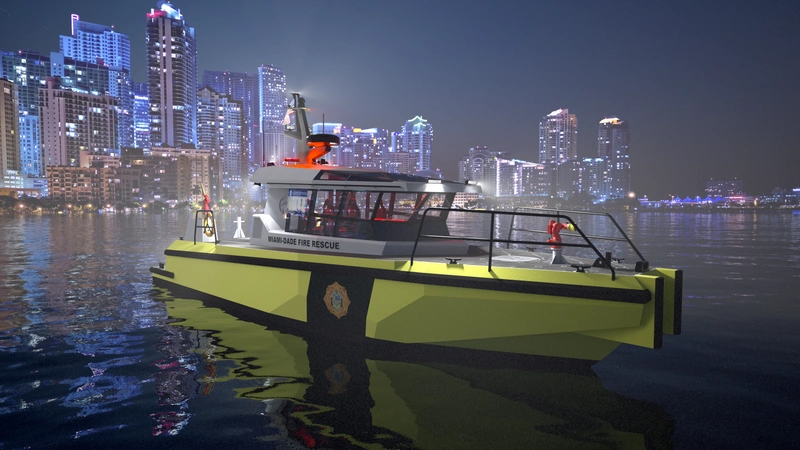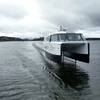INSIGHTS: Metal Shark's Chris Allard
A naval architect and graduate of the Webb Institute, Co-Owner/CEO Chris Allard introduced the engineering-centric approach that has fueled Metal Shark’s growth; driving innovation and transforming the company from a regional builder to a globally recognized industry leader.
A member of the ownership team since 2005, Mr. Allard has overseen the expansion of Metal Shark from several employees to over 350. Under Mr. Allard’s direction, Metal Shark has successfully captured over $500 million in government and military contracts while expanding into the commercial sector and becoming one of the largest suppliers of high speed ferries.
Today, at three fully self-contained facilities in Alabama and Louisiana, Metal Shark manufactures vessels in aluminum, steel, and fiberglass, with current capabilities supporting production for vessels up to 300’ in length. With all that happening today, it is also true that best may be yet to come. Listen in this month as Chris Allard tells us how, and why.
2018 was a good year for Metal Shark. Give us just a few of the major highlights and lead us into what’s new – and coming – in 2019.
Probably our biggest announcement last year was our acquisition of the assets of Horizon Shipbuilding, which brought a 35-acre Alabama shipyard into our portfolio, bolstering our steel shipbuilding capabilities and facilitating our entry into multiple new markets. Our launch of Sharktech Autonomous Vessels was another highlight. Our US Coast Guard RB-S program continued in force, with over 320 units in service by the end of 2018. In all, last year we delivered over 200 vessels to operators in a range of markets including US and foreign militaries, passenger vessels, and others.
2019 is poised to be another exciting year for Metal Shark. We’ve already delivered the first two 40 PBs to the US Navy. We’ll be in full rate production by the third quarter of 2019 with multiple large delivery orders placed so far. The small boat business at our Jeanerette production facility remains stable and robust. At our Franklin facility, high volume ferry production is ongoing, while we are also simultaneously building multiple government and military platforms. We’ll be entering new sectors in 2019 with some as-of-yet unannounced but very exciting large projects. Our Alabama yard has come on strong with faster than anticipated growth in new steel construction as well as refit and repair projects. We’re forecasting record revenues for 2019 and early indications show a projected further increase.
You now own three yards on the U.S. Gulf Coast; each providing a different sector of industry with focused output. What is your 10,000 foot view of the state of boating building in the United States today, and what are the prospects for tomorrow?
It’s an interesting time to be shipbuilder in the US today. Material and labor costs are changing faster than I’ve seen in my career. While tariffs and the current political climate are likely a driving factor, I’m concerned that we’re entering a period of more significant inflation than we’ve seen in a decade or more. Regardless of the driving factors, we see rising materials costs impacting pricing, which will in turn affect end users. While current economic indicators are generally viewed as positive, I’m concerned with the triple threat situation of high stock market, low interest rates, available capital and low fuel prices. It reminds me a lot of 2008.
The Jones Act is another area of note. We monitor Jones Act issues closely and support efforts to keep the Act in full effect. There’s significant concern that seemingly small “waivers” could lead to gradual erosion and eventual repeal of the law. Whether or not politicians or the public agree with the Act, the simple fact is that a wholesale repeal would end shipbuilding as we know it in the United States. As a taxpayer, that’s not something I think is best for our country.
An oft-raised topic within the government shipbuilding sectors is industrial base preservation. There seem to be many questions asked regarding how the government can best support the industrial base. I heard a simple, but succinct answer from a fellow shipyard CEO this year: “Just order stuff.” At the end of the day, the best way the government can support the industrial base is to do just that. It is the role of business to develop the talent and the workforce we need to support our contracts. We can be more efficient at this than the government; creatively tailoring our efforts to suit the needs of our situation. Simply put, being the industrial base is our job. With the right opportunities and well constructed requirements and contracts, the opportunity to profitably serve the government is the best driver of industrial base development that there is.
Diversification seems to be the ticket for shipyard survival in this ‘up and down’ industry. When one sector is down, another surges. Give us the Metal Shark version of ‘diversified’ operations.
We’ve done a good job of spacing our revenue stream across multiple sectors. Our version of diversification involves multiple markets, vessel types, customers, and production locations. As much as this approach adds complexity, I believe it mitigates risk.
A common thread that we often hear is that U.S. builders can’t compete with the foreign yards. However, you export a lot of hulls – and you do it well, often outside of FMS controls, and you have an international client list that returns, time after time. What’s the secret sauce?
It’s difficult to compete internationally as an American shipbuilder with only American facilities. There’s no doubt that the labor cost structure in the US is higher than many other locations, and recent tariffs have made it even more challenging to compete in a true export manner. Regardless of whether or not anyone agrees with the tariffs, it is simple fact that their current impact on cost has made it even harder to export against foreign competition. Additionally, many countries with native shipbuilding capability have similar Jones Act-like regulations, which also works against us.
We export a great deal, with FMS being a key portion of that, but certainly not all. We are blessed with dozens of repeat international buyers. We attribute this to simply designing and building a high quality product at a fair price; by focusing on the customer and providing good support. Our use of technology has helped us bridge the gap in cost, but at the end of the day the customers buy the product for the quality and service.
At this point in time, your largest LOA build history is in the 100-to-150 foot range. The smaller, aluminum manufacturing niche seems to be your sweet spot. Could you accomplish bigger projects in any of your existing yards? If so; which one?
That certainly was, and largely still is, the case today. Our core competency is in smaller aluminum new construction of boats and small ships, but with multiple different 120’+ steel and aluminum new construction ongoing in both Franklin and Alabama the range of our expertise continues to grow. By applying the high volume production methods learned in the production of smaller boats, combined with newly implemented technology, and, in some cases even incorporating more traditional shipbuilding styles, we’re creating an extraordinarily dynamic environment that allows us to address multiple projects and programs across a multitude of sectors. For practical reasons, our Jeanerette production facility will continue to focus on smaller, trailerable vessels (50’ and under), both Franklin, and even more so, Alabama, have significant upside growth potential on the size of vessels within our skill set.
Would you contemplate the purchase of another yard in the near term?
Contemplate? Certainly, and in fact I think it’s highly likely at some point. However, it is not currently our focus and I don’t expect us to execute another shipyard acquisition in the near term. That said; we do continue to watch the North East offshore wind market and would love to partner with or acquire a yard in the region as the market develops.
You are building a 150’ yacht for a private client in the Franklin yard. That a U.S. yard is building a yacht is big enough news, but using aluminum in these types of luxury vessels isn’t the rule. Nevertheless, your welding techniques have brought aluminum finishing in line with what was only thought possible with fiberglass. Can we expect more of that work in the future?
Yachts span the gamut in terms of materials; aluminum, steel, and composite. Certainly the use of composite construction has grown in prevalence in the last decade. However, aluminum offers flexibility, lower tooling costs and time advantages when building a custom vessel. The quality of our aluminum craftsmanship has resulted in an amazing finish, especially considering this vessel isn’t faired. We view the hull material as agnostic; we would build a vessel in aluminum, steel, or composite if it was the right choice for a given application. For the sake of our current build, aluminum offered the best value for the reasons just given as well as durability for the owner’s mission.
Producing 200+ boats annually keeps your yards busy, but that takes a disciplined manufacturing process. And, that’s what shipbuilding has evolved to be – a manufacturing process. Tell us about the Metal Shark approach to modernizing your work lines.
We have spent a tremendous amount of time developing and subsequently refining our manufacturing processes. It’s an ongoing effort and the only thing I’m certain of is that we aren’t done. Daily, we work to improve what we do, come up with new methods, and to push ourselves forward. We started building ferries upside down, now we construct them right-side up. Everything is on the table to be evaluated and potentially changed, and of course our diversification adds another layer of complexity. The other day, we were building a 20’ boat costing less than $100,000 while at the same time building multiple, dissimilar, 100+ foot, deca-million dollar vessels. The variety of what we do at times can be daunting.
We continue to push and rely on modern software and management tools to organize the operations. Whether it be Solidworks and their powerful modeling and product management software, our new ERP system, or work station terminals as opposed to drawings; technology continues to permeate the modern manufacturing world. The automation of cut file and drawing creation continues, as does IoT implementation, such as cloud-connected welding machines.
Technology aside, this is still a people business. As much as innovation has helped us, so have our senior operations managers. Tim Schieb, COO/President, joined us and continues to drive forward operational improvements. Industry veteran Doug Barrow has led the way in Alabama and Jon Gravois continues to drive the small boat side of the business.
Are you employing – or contemplating – robotic welding and/or any other advanced changes to your manufacturing procedures? If so, where and how?
We spent a tremendous amount of time and money implementing robotic welding a few years ago. It was a spectacular failure, so naturally we are doing the logical thing and trying again. We learned a lot in our last effort and remain convinced it will be the way of the future. Robotic welding, and other more advanced manufacturing techniques, will be the only way for US yards to retain any competitiveness in the world shipbuilding arena. While the Jones Act may steady the US shipbuilding sector, technology will be the only true way we retain a real competitive stance and or even regain a position worldwide as a leading shipbuilding nation. Beyond robotic welding, I see other advances which are also mostly focused on technology – whether that means 3D printing, virtual reality or even just more advanced software tools. I remember only ten years ago doing CRM with a server database driven program. Today, there is an app for that.
Your collaboration with ASV Global – now a subsidiary of L3 – is an interesting development. From which sector do you see the most interest in autonomous newbuilds and how quickly can it grow?
We strongly believe in the future of autonomy. In 2018 we founded our Sharktech division, which is focused on the advancement and implementation of autonomy. Our first Sharktech effort was in partnership with ASV/L3, clearly a leading name in the space. Our two companies partnered to bring ASV/L3 technology to market in a more commercially available, “check the box”-style option. While the integration of the system is more complicated than that, it’s our job to make it as simple and seamless as possible for the customer. It was an amazing project and a complete success.
We’re now seeing interest in autonomous technology from every sector. Certainly the military has multiple well-known autonomy-focused programs, and there’s also strong interest from commercial operators. Certain sectors are jumping straight to full-fledged unmanned autonomy and the pace of development is startling. Open-ocean operations can now be safely and reasonably automated. Technology development has actually outpaced the HM&E development and soon the limiting factors will be the systems on board, the need for human maintenance, and the interface for longer-than-typical durations. We are looking to suppliers, specifically on the propulsion side, to help us advance certain operations that will allow longer range, longer duration, autonomous missions with higher level of redundancy and reliability. Engine manufacturers will need to proactively work with industry to address remote diagnostics, service intervals, and inherent redundancy required for extended unmanned operation.
Not all sectors will jump straight to full autonomy; many will follow the automotive path, where the first step is human load reduction. The immediate result is an increase in safety and accountability. The ability to remote monitor fleets or missions will allow improvements to both the process and the results. The next step will be reduced manning. Eventually, the vessels will be networked and communicate autonomously behind the scenes. Imagine AIS units actually talking to each other, providing corrective actions between vessels, and reporting events to command and control, even in inland waterways.
For the future, Sharktech lies somewhere between the software autonomy providers and the traditional shipbuilder. It focuses on the “design for autonomy” elements needed to integrate and support autonomous operations, providing an engineering-centric approach to the complex problem of how to bridge the gap between software and the real-life challenges of the sea.
Ferries, municipal and government patrol boats, fireboats, yachts, survey vessels, pilot boats – and now – towboats in Alabama. What will be the next ‘big’ thing in the Metal Shark basket?
Well, it wouldn’t be sporting to share that, but I would say there are logical steps in our trajectory within our existing portfolio. We will continue to reinvest in what we do now, making sure we continue to do the best job possible. We cannot lose sight of what got us here and we must work every day to make sure we continue to grow and improve those skills. Strong efforts in Pilot boats and Fire boats will be a cornerstone of 2019. We focus our efforts on markets we where we feel we can make a measurable impact. We look for opportunities where we can develop product with a reasonably repetitive need, and apply new technology, designs, and methods.
The oft-rumored “yacht” we have under construction will be interesting to watch. It’s a unique, immensely capable vessel that will be both loved and loathed. It’s quite different than most of what the market has seen, and I am excited about where it will take us. Will we build multiple of them? I sure hope so. But more than anything, I think it will open new opportunities for us that we aren’t able to see at the moment. It will also offer another option for yacht owners who desire to build a customer yacht domestically. A contraction in that market has left few options for Americans who want to build in the United States.
Longer term, you can expect to see Metal Shark continue its geographic diversification, both domestically and internationally. American-owned shipyards can compete globally. International shipyards and shipbuilders routinely span multiple countries, so why can’t American shipyards do the same?
This article first appeared in the April print edition of MarineNews magazine.







